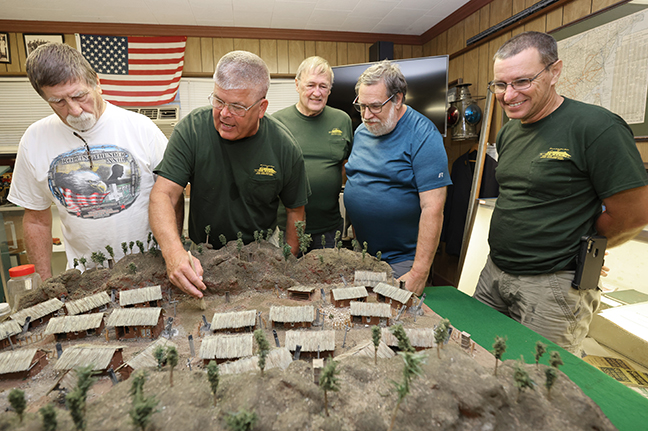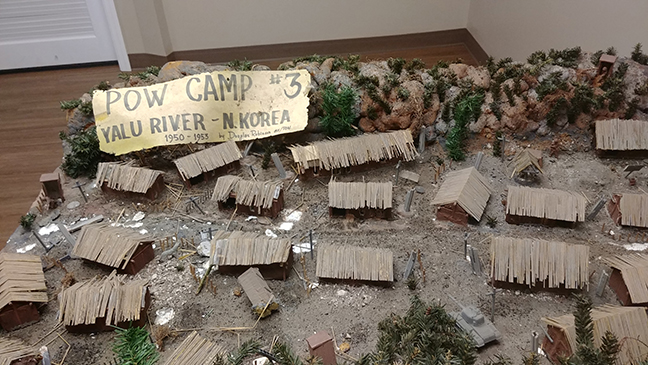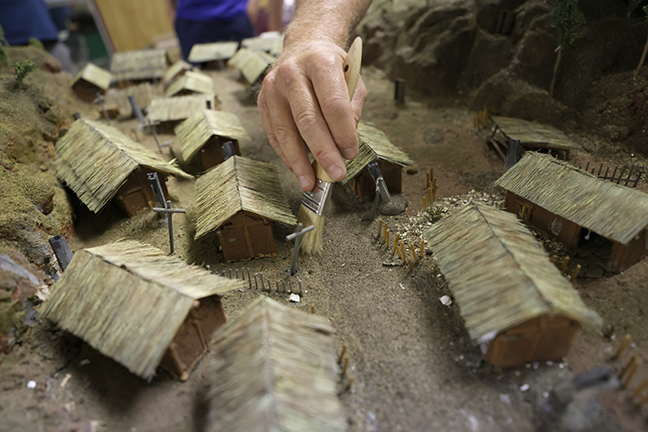A POW Memory Restored: Locals restore a unique piece of art

Scott Main, second from left, works on restoring a model of Korean War POW Camp #3, as, from left, John Hall, Jim DeLawter, Marty Shapiro and Jerry Stone, look on at the Ocala Model Railroaders on Northeast 3rd Street in Ocala on Sept. 28. [Bruce Ackerman/Ocala Gazette]
That’s how the model of a Korean War POW camp looked when Ocala/Marion County Veterans Memorial Park volunteers Bill Ehrhart and Carlos Gonzalez rediscovered it in February.
The model had been locked away for nearly 20 years in the cramped Marion County Veteran Services’ storage shed where Ehrhart and Gonzalez went looking for a display case for the Marion County Veterans Exhibit and Education Center—an extension of the park in northeast Ocala.
“As soon as I saw it, I knew we needed it,” recalled Gonzalez. “It’s a work of art. What the heck was it doing forgotten in that shed? It just kind of fell through the cracks I suppose.”
“We honestly didn’t know it was there,” added Ehrhart, an Army veteran of the Vietnam War. “It was lying there, dilapidated and badly in need of reconstruction.”
In Ehrhart’s mind, the model was perfect for the education center’s Korean War Room, but he couldn’t immediately think of anybody who could take on the job of restoring it.
It took some research on Ehrhart’s part to discover that Douglas G. Robinson had built the camp model and donated it to the park.
What is Known
Robinson passed away on Oct. 21, 2008 at the age of 76, according to an obituary published by the “Citrus County Chronicle” on Oct. 22 of that year.
Born in 1932 in Canton, New York, Robinson was an Army veteran of the Korean War. He was a private in the 2nd Infantry Division, 82nd Airborne Anti-Aircraft Battalion. He received the Purple Heart and was a Prisoner of War (POW) for 33 months, from 1950 to 1953, in POW Camp #3 along the Yalu River in Ch’ang-Song, North Korea.
According to park records, Robinson donated the model of his POW camp on Oct. 31, 2001, just over 20 years ago. It is not clear when he created the work.
Nothing was written on the donation form apart from: “POW Camp display—with buildings,” and Robinson’s printed name. The address line was left blank, along with city, state and zip code.
The model came with a hand-lettered sign: “POW CAMP #3 YALU RIVER—N. KOREA 1950-1953 by Douglas Robinson ex/POW.”
Robinson was survived by his wife of 35 years, Lillian P. (Seney) Robinson of Inverness, according to his obituary, as well as daughters Elaine L. (Steve) Simons and Denise M. Charest.
A brother, Howard, of Chicopee, Massachusetts, and a sister, Beatrice, of California, were also listed, along with grandsons, Craig, Tim and Barry Simons, and a granddaughter, Wendy Boling.
Attempts were made to contact Robinson’s family members through information accessible to or requestable by the public and media, and also by Ehrhart, to no avail.
Forgotten War
The Korean War, or the conflict between the Democratic People’s Republic of Korea (North Korea) and the Republic of Korea (South Korea), started as a civil conflict in 1945, but reached international proportions in June of 1950.
With encouragement and support from the Soviet Union, North Korea invaded South Korea, which prompted the United States to join the war on the side of the South Koreans.
After more than a million combat casualties, the fighting ended in July 1953 with Korea divided into two hostile states at the frontline of the now forever-paused but never-finished war. A de facto boundary line still exists to this day, waiting for a peace treaty.
But not every combatant of that war left its battlegrounds and came home. As many as 7,245 American soldiers and airmen, were captured by the North Koreans, approximately 2,806, or 39%, died in captivity.
And some didn’t want to leave—23 American POWs famously chose not to repatriate to America when given a choice.
In 1950, when Robinson and his fellow POWs were marched to Camp #3 in what was called the “Tiger Death March,” according to Ehrhart’s research, named after Col. Chong Myong Sil of the North Korean People’s Army, he and his compatriots were treated brutally.
With few medical supplies and little food, disease was rampant. Many didn’t survive the march. From what information Ehrhart could find on Camp #3, it housed roughly 728 POWs. Of that number, only 182 survived.
Robinson was one of them.

A before-restoration photo of Robinson’s model after it was rediscovered. [Photo Courtesy Jim DeLawter]
After being asked to view photographs of the model, Dr. Conrad Crane, Chief of Analysis and Research at the U.S. Army Heritage and Education Center, part of the Army War College (AWC), and an expert on the Korean War, consulted with some of his colleagues at the AWC.
He soon reached a conclusion that Robinson’s model was one of a kind in the country.
“I’m not aware of any other model like it anywhere,” Crane said via phone. “It’s visual evidence of what one of those camps looked like. I’ve read some descriptions from POW memoirs, but I’ve never seen a sketch. I’ve never seen a photo. This model is truly a unique artifact.”
Crane said he believes Robinson may have created his model as a way of working through the trials and tribulations of post traumatic stress disorder (or PTSD), which he further surmised Robinson likely suffered from.
“He would have gone through an immense amount of hardship,” speculated Crane. “I don’t know much about Mr. Robinson, but that does tell me a lot about him. The amount of fortitude it would take to go through 33 months of captivity in those primitive conditions. That is just phenomenal.”
“You can’t escape it,” he added. “And I’m sure that building his model was a way for him to purge himself of some of those memories and relieve some of the stress of that experience. I’m sure for him it was a very therapeutic exercise. And we’re all the richer for it.
“Men like Mr. Robinson, they sacrificed more than three years of their lives there. They sacrificed all of their lives there. We need to consider that—appreciate that.”
Better than a Picture
At roughly four feet long and three and a half feet wide, the model, both Ehrhart and Gonzalez thought, would be too big to fit in the Korean War room of the education center.
“The original thought was to cut it down,” said Ehrhart. “Just make it a little bit smaller, right? It’ll fit better in that room.”
But that idea was quickly abandoned after they learned of the model’s unique qualities.
Meanwhile, Ehrhart emailed the president of the Ocala Model Railroaders (OMR) Jim DeLawter to see if he might be interested in restoring the model.
DeLawter responded immediately. He said he would take the project before their board. Within the week, the board members had agreed to restore the model.
“I was thrilled to death,” recalled Ehrhart. “I wanted to jump 10 feet in the air. It was like a big weight was off my chest.”
The next steps were tentative.
“All we knew was that this man built this thing from memory,” Ehrhart said.
Much of the Korean War, photographically speaking, is still top secret or not as publicly available, in comparison to say the Vietnam War or World War II.
According to Crane, the average Google researcher might find some satellite pictures of the location of where Camp #3 was once located, but that’s roughly it.
“Mr. Robinson’s model includes details and impressions far more specific than anything we can really look at right now in a satellite image,” said Crane. “That’s part of why it’s so special.”
After the model’s rediscovery, people kept asking Ehrhart if there were any pictures of Camp #3 to compare it to. He said his response grew quickly into a refrain.
“You’re looking at a picture!” he said he would tell them “You’re looking at the picture that Douglas Robinson had in his mind.”
“This model is so much better than a picture,” he said with emphasis.
Moving Meditation
Patricia Tomlinson, an archeologist and head curator of exhibitions at the Appleton Museum of Art, College of Central Florida, said that “models do what no drawing or photograph can do—envision space in a concrete, substantial way.”
“There is poignancy to this piece,” she said after she viewed pictures of the model, “and I can’t help but feel that the maker was creating the model not only to document what he and other POWs had been through, but to come to terms with the horrors endured.
“The physicality involved in making the model perhaps even served as a moving meditation on grief, loss and survival,” she added.
Patrick Spiro, an Army vet who lives in Marion County, uses art as a vessel for all the things he experienced and is still processing from his time serving in Afghanistan.
After he saw pictures of Robinson’s model, Spiro immediately identified with what he imagined the POW was trying to do and say with his creation.
“I think he wanted people to look at it,” Spiro said. “Maybe it helped him find closure to look at it too. I can see where he might want to put what he was seeing, maybe when he closed his eyes at night, and make a physical picture, for [others] to see.”

Scott Main works on restoring the model on Sept. 28. [Bruce Ackerman/Ocala Gazette]
Scott Main, a retired Army colonel, DeLawter and Neal Frisbie, who died of COVID-19 in early September, were three of the main OMR restorers on the project.
The restoration crew worked for a couple of hours every Tuesday evening starting in March. From Main’s point of view, the process was more like retracing along Robinson’s lines than redrawing anything.
“We didn’t change the structure or the layout, or the composition,” said Main. “All we really did was address some scale issues. We re-colorized the best we thought of what the local area would look like because the original colors were pretty much gone from age.”
They emphasized the points he had made in his work, said Main, to tell the story he wanted to tell as best they could.
“I would say we refined it,” added Main. “Stuff that had gotten broken or stuff that didn’t look as good, we fixed and replaced. It’s just attention to detail and layering the colors and the material on to reflect the landscape, and that just takes a while.”
According to Main, Robinson built his model using modeling clay and plaster of Paris. The original roofs, replaced in the restoration, were made from an old stick broom and popsicle sticks. Robinson used practical paints and materials, stuff one could find in any Walmart, Lowe’s or Home Depot, Main said.
It was even discovered that the model had been previously wired for sound.
“Originally, he had speakers in this,” said Main, “allowing him to play music. Speakers in the buildings in the hills. But we don’t know what music or whatever he intended to be played.”
Was he playing propaganda or something like that? Jungle sounds? Korean music?
“We have no idea,” said Main. “There was an intention for sound. He wanted sound to be involved. We know that much. We just don’t know in what capacity he wanted it.”
Since the OMR group received the model in March, Main estimated that close to 400 total hours has been spent on restoring it, with the work spread out between everyone who volunteers with the organization.
For Main and the others, it was a labor of love; a duty they were honored to fulfill.
Never Forgotten
Currently, Ehrhart is looking forward to the restored model’s eventual return to the education center—OMR is shooting for December or sooner—where it will in fact reside in the Korean War Room as a permanent part of the museum.
The price Robinson paid to bring this model to life, so future generations can learn from and understand the cost of his service, should be remembered, said Ehrhart.
“It’d be nice to show people what happened to this soldier, what this man went through for our country,” he said. “The restoration of his model guarantees that sacrifice will never be forgotten.”





